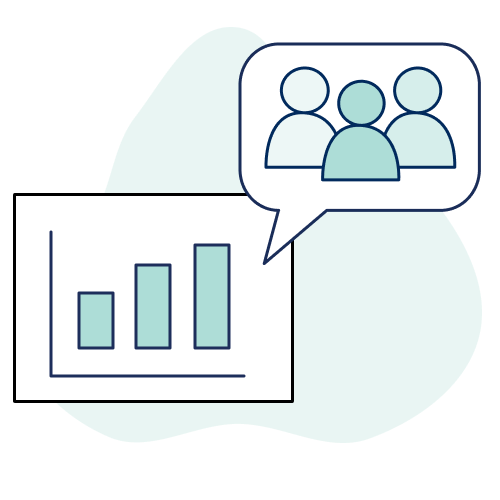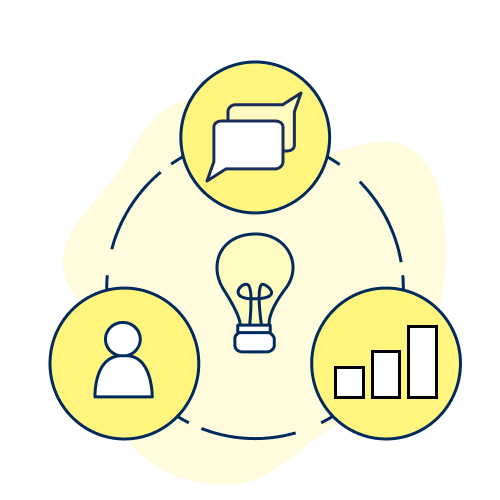Ajeetha reflects on her early assumptions about qualitative and quantitative research, and the deeper insights to the relationship between qualitative data and design thinking that she had discovered during her academic journey at U of T.
Written by Ajeetha Vithiyananthan, Blog Editor & Digital Content Writer, Bachelor of Science, Psychology and Sociology
Science fairs were a big deal at my middle school. Near the end of every spring, for an entire afternoon, rows and rows of colourful tri-fold display boards would line the tables in our gymnasium. At a school that prioritized STEM education, electricity generated from potatoes and miniature volcanic eruptions — basic and overdone — were rare.
At the time, I was less interested in biology, chemistry, or physics and more interested in how humans think, feel, and behave. Is social media addiction real? How do we perceive beauty? And why might these differ from person to person?
I was worried though: psychology was seen as a “pseudoscience” by some, and I didn’t want to be “less” scientific than my peers. I wanted to hear my classmates’ experiences, but peer testimony didn’t seem like a proper method. A limited sample felt like a biased sample. And words didn’t seem to have the same power as averages and trendlines.
In the end, I collated and presented statistics from published studies on brain activity, heart rates, and reaction times. Science was about reliable, numbered data — or so, I believed.
The Quantitative Bias in Science

Here’s the deal: Generally, quantitative research — gathering and analyzing numerical data — is seen as more reliable, replicable, generalizable, and objective without ambiguity or bias. In comparison, qualitative research — gathering and analyzing descriptive data — is seen as anecdotal and subjective at best, or unscientific and biased at worst.
So, when I entered university, I very hesitantly chose to major in psychology and sociology. Social sciences, with their use of qualitative research, are seen as less rigorous and less credible than the physical sciences; they’re called “soft” sciences or denied belonging in science altogether. By also minoring in statistics, I felt I could “redeem” myself.
But at U of T, I soon came to learn that it wasn’t that straightforward.
Quantitative research can be biased. Psychology has been going through a replication crisis, meaning researchers have been unable to replicate the findings of many numerical-based behavioural studies. There are several reasons, but an interesting one is publication bias: as journals are incentivized to publish interesting, statistically significant findings, researchers might be too flexible with their data analyses to get such findings.
The so-called “hard sciences” aren’t immune to this either. In one survey, 77% of biologists and 87% of chemists surveyed said that they had tried and failed to replicate published research findings. So quantitative research isn’t without its pitfalls.
Also, isn’t it quite funny to try to quantify people? Humans are diverse and complex. People’s psyches, whether on an individual or group level, cannot be explained simply through data points and trendlines.
People’s stories matter. And if I was interested in finding a solution for people’s issues, their stories need to be considered even if they’re not quantifiable.
Discovering Design Thinking

When I joined the Innovation Hub, or iHub, as a Blog Editor, I was curious about its emphasis on “student-centred design thinking.” I’ve been taught that finding the right experimental or ethnographic design was the first step to finding the statistics or themes that best described the subjects of my interest.
The reverse idea — of research leading to design — was alien to me.
Design thinking, I soon came to learn, is the practice of making empathy-based observations and interviews to design programs and services that best fit human needs. Design thinking research is meant to be an exploratory and non-linear process in which depth is just as important as breadth.
Also, the qualitative data at iHub is collected through interviews with U of T students by U of T students. In design thinking, peer feedback isn’t biased — it’s exactly what’s needed to foster a welcoming environment and gain genuine insights from students.
Since 2021, iHub has partnered with the Faculty of Arts & Science in reviewing academic programs based on the University of Toronto Quality Assurance Process (UTQAP) criteria. This project gathers quantitative data in the form of surveys, and qualitative data in the form of student interviews. These insights, in turn, help inform the future of various Arts & Science programs at U of T. Even at a high level, the university engages in design thinking processes that are made possible through a combination of quantitative and qualitative methods.
Unlearning Assumptions

As I move closer towards the end of my undergraduate studies, I’m glad to have unlearned the assumptions I had about qualitative and quantitative research when I first began my post-secondary journey — and I’m glad to have the opportunity to unravel them with you:
- Social sciences are subjective, but that doesn’t make them less scientific: Interpreting human behaviours can’t be as straightforward as examining moving particles. Bias is bound to worm its way in, but keeping awareness of how one’s personal biases can affect interpretations helps with maintaining a sense of objectivity. As long as you’re practicing empiricism — making external observations and not relying on internal reasoning — you’re a scientist.
- Qualitative data, even from a limited sample, is valuable: Qualitative data is meant to be exploratory, a springboard for further, focused research. From the data, we can create theories and keep building on or testing these theories as we gather more data. And while small samples are considered non-generalizable or without “statistical significance,” that’s not what they’re for. A small sample provides more time for skilled facilitators to get stories that get at the ‘how’ and ‘why’ behind interviewees’ feelings and experiences.
- Qualitative and quantitative research go hand in hand: Both methods are useful for different purposes, and when they come together, they can reveal a lot about the social world. In educational research, for example, qualitative research can examine student-teacher perspectives on a new teaching method, while quantitative research can evaluate its effectiveness through testing and scoring. Healthcare, market research, public policy, UX design, and more can make use of both methods.
If I could redo my science fair projects with all that I’ve learned over the years, I would’ve surveyed and interviewed classmates; stated my personal biases at the outset; and followed up with even more questions than I had started with — scientific exploration at its finest.
As I continue to do science — observe, probe, theorize, test — I’ll remember these lessons learned, and I hope you do as well.

0 comments on “Qualitative and Quantitative Research ”